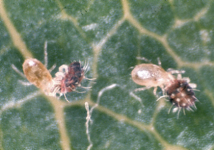Dry Decisions: Mite management without oil.

Brief: The use of late season pyrethroids to manage stink bug have significantly reduced the overwintering populations of predatory mite that provide biological control of the spider and rust mite complex. As temperatures rise, European red and two-spotted spider mite will mature faster and produce young at a higher rate, leading to rapid rise of mite populations. Subsequently, mite feeding then leads to tree stress, reducing fruit quality and return bloom (Beers,E.H. 1987). Additionally, use of some insecticides to control codling moth have been shown to cause ‘mite flaring’. Many of the miticides do not require the addition of oil, and as such, should be strongly considered if Captan is employed for summer disease management. Keep an eye on foliar color changes as management of mite, prior to bronzing, will help to maintain fruit quality and return bloom.
Depth: Since 2011, the brown marmorated stink bug has become an agriculturally economic pest of tree fruit in Hudson Valley. A number of farms have employed effective insecticides against this pest, primarily those in the pyrethroid class. The use of these broad-spectrum insecticides has been shown to reduce populations of biological control agents in the orchard, specifically mite predators. In orchards where T. pyri, (Typhlodromus pyri (Acari: Phytoseiidae)), a native predatory mite that feed on phytophagous mite populations are established, they will reduce and keep in check early season European red mite and two spotted spider mite populations.
The use of Carbaryl at thinning (WP formulations), along with the use of the fungicide Manzate to manage apple scab, will also contribute to the rise of mite during the season. Recent studies of insecticides used to manage the codling moth have been shown to ‘flare mite’. These include one or more insecticides in the spinetoram (IRAC Group 5), anthranilic diamide (IRAC Group 28) and neonicotinoid (IRAC Group 4A) classes (Wise 2011, 2010). Early mite populations in June can significantly reduce photosynthesis, resulting in lower fruit size and quality, requiring mite management. Our weather has turned to warm and dry that contributes to mite success, increased populations resulting from the reduced time required to complete a single generation. 
The use of Captan as a contact fungicide against apple scab (Venturia inaequalis) and now for sooty blotch and flyspeck management, is considered to be an essential part of early and mid-season management of apple. This is especially true in years of intermittent showers leading to reduced fungicide residual.
That said, the use of oil employed in insect and mite pest management acts as a penetrant to pull materials into foliage and fruit. This is the case when Captan molecules are pulled into the leaf cuticle where its activity as a biocide causes phytotoxicity to surface of plant cells, resulting in economic damage to leaves and fruit in sensitive varieties.
Oil use will also increase the uptake of Carbaryl, increasing the thinning response. In a year such as this with freeze events causing significant ‘natural thinning’, oil residue with carbaryl may lead to excessive thinning. In years of sustained succulence (col and moist), the use of oil in the presence of Captan may injure the fruit of certain apple (light-skinned varieties such as Golden Delicious).
For many growers, the backbone of mite management in the Hudson Valley since the late 1990’s has been the use of Agri-Mek®. The active ingredient, avermectin, is a naturally occurring compound, developed through the fermentation process by Streptomyces avermitilis, a soil bacteria in the actinomycete group. Abamectin is a very effective material for use as a miticide against the pome fruit mite complex. It is one of the most effective materials against apple and pear rust mite, providing season long control of this pest in most years.
Agri-Mek® SC (Syngenta) is a water based formulation employing 8.0% Abamectin for use rates between 2.25 and 4.25 fl.oz./A. in IRAC’s Group 6 mode of action. This formulation MUST ALWAYS be mixed with a penetrating non-ionic surfactant, such as horticultural spray oil used at 0.25% to be effective. Applications of Agri-Mek without a penetrating surfactant will result in significant reduction in the efficacy and/or residual control of the insect and mite population. This would include formulations of abamecin in Agriflexi (Syngenta), a premix formulation with thiomethoxam (Actara) and abamecin (Agri-Mek).

Many of the novel miticides do not require oil. Attached are charts of studies comparing miticides near petal fall. Hexythiazox (Savey 50DF at 3-6 oz./A, Onager at 12-24 oz./A ) in IRAC 10A and Etoxazol (Zeal at 2.0-3.0 oz./A) in IRAC 10B provided excellent control of the European red mite (ERM) population without teh use of oil. These active ingredients act primarily as larvacides (nymphs) and ovicides (egg) of ERM. Through translaminar movement, Zeal enters the leaf and is fed upon by the mite, leading to low viability of the ERM egg (reduced hatch) when fed upon by adults. Hexythiazox appears to be less effective against the two-spotted spider mite population on apple, whereas Etoxazol provides excellent TSSM control, making it a strong late season miticide as TSSM move into the tree canopy.
Remember that as temperatures rise, mite will mature faster and produce young at a much higher rates leading to rapid rise of mite and injury to trees. Check blocks frequently for bronzing of the interior leaves and sample leaves in question with a hand lens (Mite Sampling PMEP Guidelines). Mite threshold in June is 2.5 mite per leaf sample.
References:
Beers, E. H., L. A. Hull, and J. W. Grimm. 1987. Relationships between leaf: fruit ratio and varying levels of European red mite stress on fruit size and return bloom of apple. J. Amer. Soc. Hortic. Sci. 112: 608-612.


